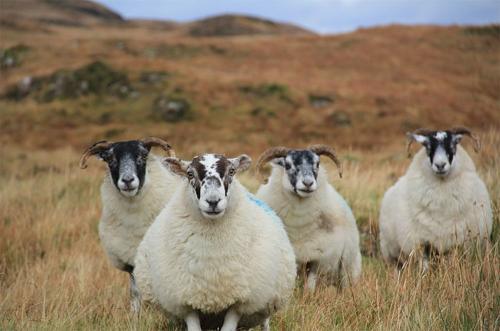The bacterial pathogen Chlamydia abortus is responsible for causing the disease ovine enzootic abortion (OEA), also known as enzootic abortion of ewes (EAE). It is the most common infectious cause of reproductive loss (causing abortion usually in the last three weeks of pregnancy) in sheep in Scotland and the UK, as well as being common throughout the world.
The disease can be controlled using two types of commercial vaccines (based on the live and inactivated pathogen), although there are safety and other issues with both types reducing their effectiveness (efficacy). In a bid to produce a safer vaccine that cannot cause disease in animals and remains effective, we have developed a new novel vaccine through a series of experimental trials funded through Scottish Government Strategic Research Programmes (2011-16 & 2016-22). This work has also underpinned a successful bid to the European Union’s Horizon Europe Programme to take the vaccine forward to commercialization with a major animal health company.

Stage
Directory of Expertise
Purpose
The bacterial pathogen Chlamydia abortus is the most common cause of reproductive loss (lamb death in utero) in sheep in Scotland, the UK and Europe. The pathogen is zoonotic meaning that it can also be transmitted to humans, in whom it can be life-threatening and cause spontaneous abortion or stillbirths.
While the disease can be controlled through vaccination, inactivated vaccines have a lower level and shorter duration of effectiveness or efficacy, while live vaccines have been shown by us to cause infections and abortions in some animals. We have also shown with collaborators in France that infections resulting from vaccine administration can also be transmitted to uninfected sheep and cause infection and abortion.
As part of our work under the Scottish Government Strategic Research Programmes we have developed and evaluated a new novel vaccine based on the extracted proteins present on the outer surface of the bacterium. The fraction which is known as a COMC or chlamydial outer membrane complex was analysed in a series of trials to determine its ability to protect pregnant sheep from becoming infected and causing disease, resulting in the death of their unborn lambs.
Results
In a series of laboratory experiments we have been successful in simplifying the processes required to produce the vaccine, including maximising the production and yield, in order to ensure that it is cost effective to manufacture on an industrial scale. The results and outcomes will enable the vaccine to be manufactured so that it can be sold at a comparable and competitive price-point to the vaccines currently on the market.
The prototype vaccine has also been evaluated in a series of trials, the first comparing it to one of the commercial vaccines and to another test vaccine (Figure 1), while others focused on determining the lowest dose of the vaccine that can be administered without affecting vaccine efficacy (effectiveness), as well as ensuring that a single inoculation of the vaccine is equally as effective as two inoculations at the determined optimal dose.
Figure 1. Effectiveness of two experimental vaccines (COMC and OG-MOMP) in protecting sheep from experimentally-induced EAE, in comparison to one of the commercial vaccines (Com Vac), as well as unvaccinated diseased animals (Chall ctrl) and healthy unvaccinated animals (Neg ctrl). The COMC vaccine protected the sheep from disease, resulting in no abortions, very little pathology, and the lowest amount of shedding of the pathogen in vaginal excretions during birth of the lambs.
The final trial assessed a range of adjuvants (components of vaccines added to boost the immune response to the vaccine) to determine which elicited the best protective response.
The overall results showed that the optimized vaccine was highly effective in reducing disease in infected animals, effectively reducing the deaths of lambs by 95-100%.
Benefits
Sustained Scottish Government funding has led to the development and evaluation of a new novel prototype vaccine to protect against OEA that is more efficacious than current commercial inactivated vaccines and safer than the live commercial vaccines. This government investment also led to a successful bid to the European Union Horizon Europe programme to take the vaccine through to commercialization with a European veterinary vaccine manufacturer through optimizing the vaccine manufacturing process.
OEA has been estimated to cost the UK agricultural sector, which has the largest sheep population in Europe (approx. 25M of a total population of 62M), upwards of £20M per year. Taking into account the sheep population in the rest of Europe and indeed worldwide, we can see the impact that an improved, safer vaccine could have on economies here at home and worldwide.
We also need to take into account the enormous benefits it could have on the health and welfare of the animals through a massive reduction in deaths of their lambs. The pathogen is also zoonotic meaning that it can be transmitted to humans, with pregnant women being most susceptible to infection, which can cause spontaneous abortion as well as also potentially life-threatening for the women if left untreated. Thus, although human infections are much rarer, a reduction in the burden of disease on animals, will also have a positive potential Impact on human infections.
Project Partners
Moredun Research Institute
Biomathematics and Statistics Scotland